コラム
落合憲弘
John Sypal
タカザワケンジ
なぎら健壱

In Japanese media and popular culture, the bubble economy era (1986-1991) is collectively, visually and, in the 2020s, wistfully portrayed as a heyday of wild corporate success- think stacks of money and Japan Inc. grey suits and wild new products by day- with neon nights of mirrored nightclubs, Ferraris, and wealthy youth in bright suit jackets with large shoulder pads. A time of new-money consumption, excess and over the top positivity and confidence.
Rather than document the trendy, gaudy excess, Mitsugu Ohnishi spent the late 80’s and early 90’s not in Roppongi or Shinjuku where all the obvious flashy action was, but instead wandered around Tokyo’s growing eastern suburban sprawl with his Makina 670 medium format camera.
Out here in the sleepy villages on the outer Eastern edges of Tokyo pre-war tiled homes and rusty, industrial shacks of suddenly found themselves in the shadows of new housing developments and shiny post-modern pachinko parlors. Rivers were straightened and, with their banks securely concreted, landscaped into a park. The coastline of Tokyo Bay too, home to fishermen for centuries was further filled out and built up. Upon these the vast expanses of fresh seafront property Sim-City-like condominium developments grew. The environment was ripe for land development and photographs.
What Ohnishi discovered were, in addition to the changes to the landscape, the people themselves- ordinary families and individuals caught in a mixture of tradition and leisure. People are at ease- but in the vastness of the newly manicured suburban landscape they are at times apart. Through a sense of distance Ohnishi’s photographs cleverly balance wry, slightly surrealist moments with a tinge of pathos. Artificial things abound- a fake elephant, an inflated play castle, goldfish catching ponds (childhood fun, goldfish hell), a cowgirl with her Shetland pony- Ohnishi’s interest isn’t strictly of these kitschy things themselves but rather the slight mismatch- a gap- between their implied intention and how they exist in daily (or photographic) reality.
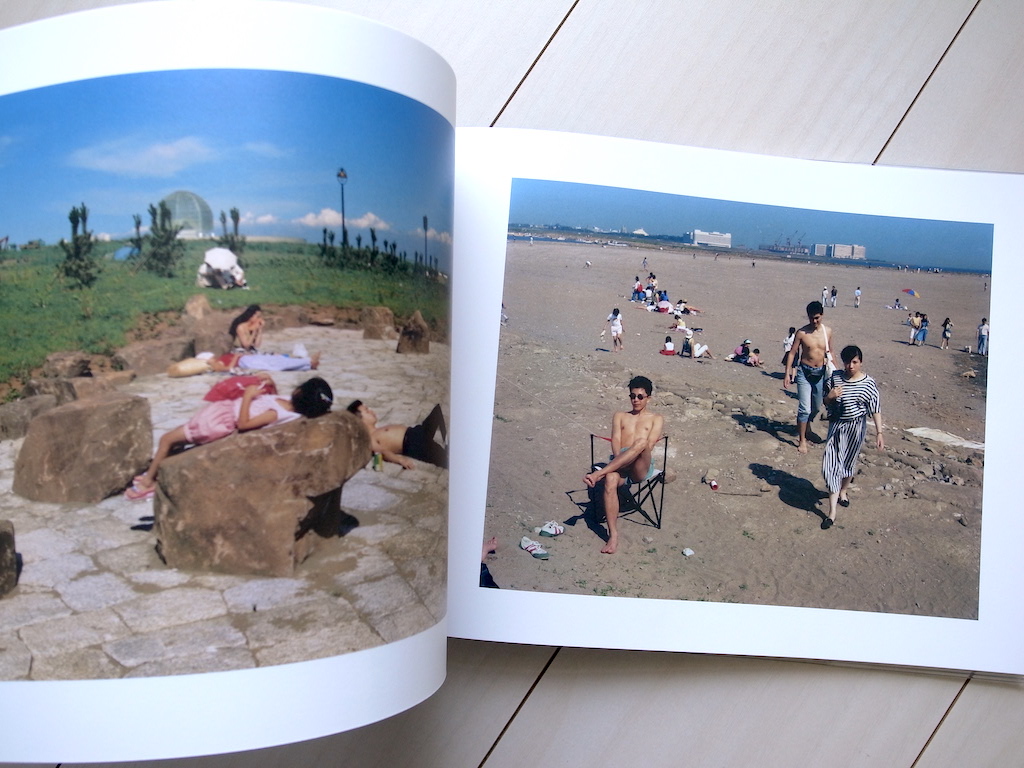
Ripples of this sort of mismatch, this tension is, found not just in festivals or amusement but in human connections as well. Many earlier pictures portray a group-oriented approach to leisure- but as the pages are turned more people are alone, together, often in new modern pursuits like oily sunbathing and leisure sail boating. The final image- one of my favorites in the book- is of six couples at various distances walking on an unfinished expanse of manmade dry land- on the horizon are new condo complexes, gleaming in the setting winter sun.
The bubble’s popped- time to go home.
Tokyo East Waves collects three series of Ohnishi’s work- together they make for a fascinating book, and one that’s well-designed. The vinyl jacket is an interesting touch- I assumed at first that its waterproof nature was a tongue-in-cheek reference to all the beaches and pools which appear in the book but at the opening reception was told its vinyl gleam was intended to echo the oil on the glistening sunbathers in the book.
The printing nicely captures Ohnishi’s sense of Blue- and the book concludes with short essays by photographers Ken Ohyama, Hiromi Tsuchida, and Ohnishi himself.
Tokyo East Waves will definitely be on my Favorite Photobooks List of 2024. I absolutely recommend this book is for anyone interested in this era of Japanese history, or color street photography in general. An instant classic!
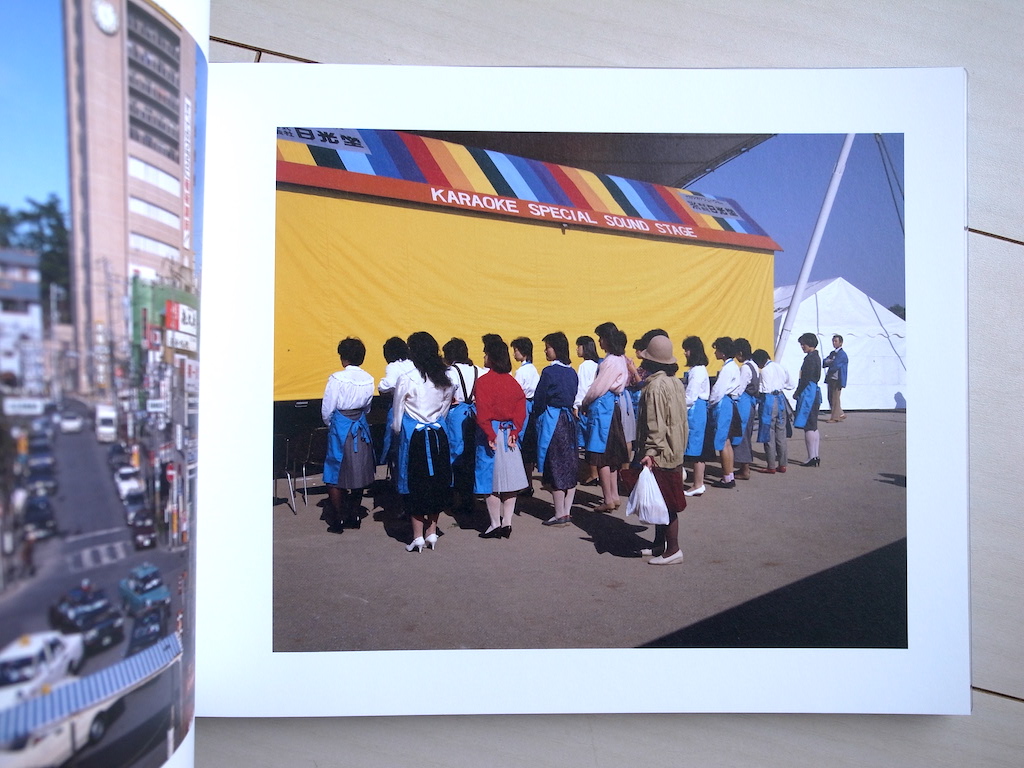
2020年代現在、日本のメディアにおいて「バブル経済時代」(1986-1991)は、視覚的にも、奔放な企業成功の全盛期として描かれています。昼間はサラリーマンの代名詞とも言えるグレーのスーツや札束、最新製品を思い浮かべ、夜は鏡張りのナイトクラブ、フェラーリ、大きな肩パッドの派手なスーツジャケットを着た裕福な若者たちがネオンに彩られています。ニューマネーによる過剰消費、そして過剰なまでのポジティブさと自信の時代だったように感じます。
しかし、大西みつぐさんは、1980年代後半から90年代前半にかけて、流行の派手な過剰さを記録するのでも、派手なアクションが目立つ六本木や新宿でもなく、プラウベルマキナ670の中判カメラを持って、成長し続ける東京の東部郊外の開発途上の地を歩き回りました。

東京の東の外れにあるのんびりとした町では、戦前の瓦葺きの家や、錆びついた工業用の掘っ立て小屋が、宅地開発やピカピカなパチンコ屋の影になっています。川はまっすぐに整備され、川岸はコンクリートで固められ、公園として整備されました。
東京湾の海岸線は、何世紀にもわたって漁師たちが暮らしてきた場所です。その上に、シムシティーのような広大な海沿いのマンションが開発されました。土地開発と写真撮影のための環境は整っていたのです。

大西さんが発見したのは、風景の変化に加えて、伝統とレジャーが混在する普通の家族や個人といった人々そのものでした。人々はくつろいでいますが、新しく手入れされた広大な郊外の風景の中で、それまでにはなかった距離感が生まれているように見えます。大西さんの写真は、それらの距離感を通して、軽妙で少しシュールな瞬間と、哀愁の色合いのバランスが巧妙です。
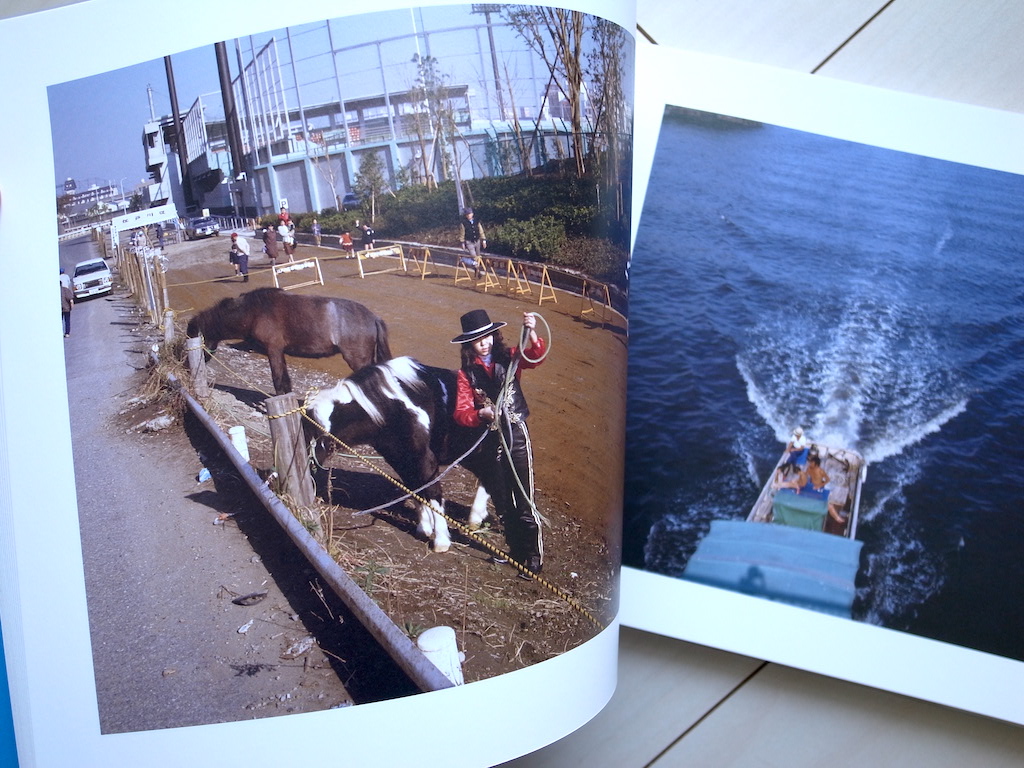
偽物の象、膨らませたお城、金魚を捕まえる池(子供の楽園、金魚地獄)、ポニーを連れたカウガールなど、人工的なものがあふれているが、大西さんの興味は、こうしたキッチュなものそのものにあるのではなく、むしろそれらが暗示する意図と日常的(あるいは写真的)な現実との間にある、わずかなミスマッチ、ギャップです。

このようなミスマッチの波紋は、お祭りや娯楽だけでなく、人と人とのつながりにも見られます。しかしページをめくるにつれて、油まみれの日光浴やレジャー用の帆船など、現代的で新しい楽しみ方をしている人も多く見られます。水平線には新しいコンドミニアムが建ち並び、冬の沈む太陽に照らされて輝いています。
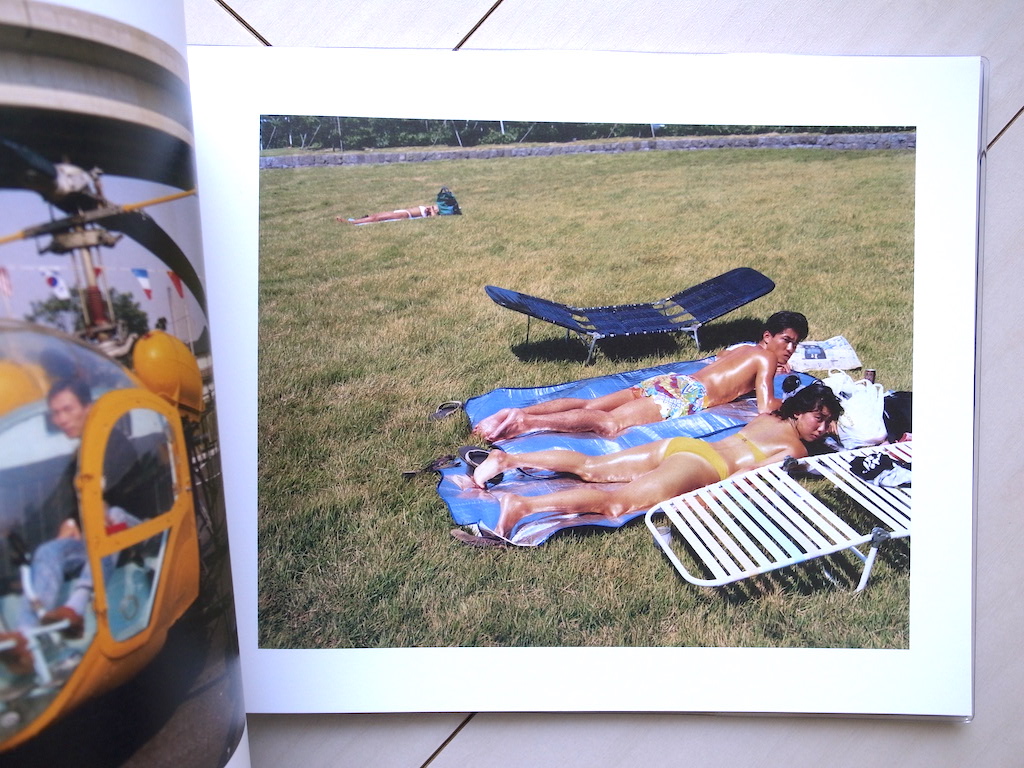
写真集『TOKYO EAST WAVES』は、「河口の町・江東ゼロメートル地帯84」「周縁の町から」「NEWCOAST」の3シリーズが合わさって構成されたことで、より魅力的な本になっています。本を包むビニールのジャケットも面白いデザインです。
私は最初、カバーの防水性はこの本に登場するすべてのビーチやプールに対する皮肉だと思ったのですが、写真展のオープニング・レセプションで、そのビニールの輝きは作中で輝く日光浴をする人たちのオイルを想起させることを意図したものだと聞きました。なるほど。
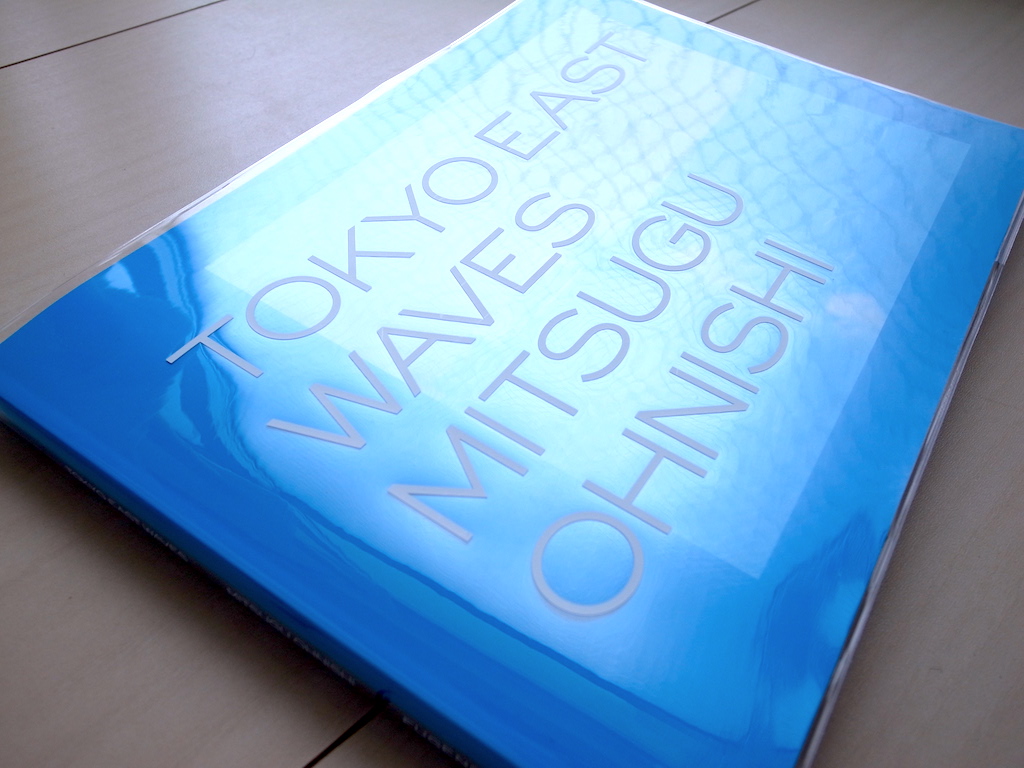
印刷は大西みつぐさんらしいの「青」の感覚をうまく捉えており、写真家の大山顕さん、土田ヒロミさん、そして大西さん自身によるエッセイで締めくくられています。
『TOKYO EAST WAVES』は、2024年の私のお気に入り写真集リストに間違いなく入るでしょう。日本史の中でのこの時代、あるいは一般的なカラー・ストリート写真に興味がある人には、絶対にお勧めの一冊。インスタント・クラシックだ!
- Mistugu Ohnishi "Tokyo East Waves"
- 大西みつぐ『TOKYO EAST WAVES』
- 発行所:ふげん社
- 発行日:2024年3月20日
- 寄稿:大山顕、土田ヒロミ
- デザイン:宮添浩司
- 仕様:A4変型(280×200mm)、144頁、PUR並製本、ビニールカバー
- 定価:6,600円(税込)
- https://fugensha-shop.stores.jp/items/65f16cfcb6945904bf1efd58


PCT Membersは、Photo & Culture, Tokyoのウェブ会員制度です。
ご登録いただくと、最新の記事更新情報・ニュースをメールマガジンでお届け、また会員限定の読者プレゼントなども実施します。
今後はさらにサービスの拡充をはかり、より魅力的でお得な内容をご提供していく予定です。
 「Photo & Culture, Tokyo」最新の更新情報や、ニュースなどをお届けメールマガジンのお届け
「Photo & Culture, Tokyo」最新の更新情報や、ニュースなどをお届けメールマガジンのお届け 書籍、写真グッズなど会員限定の読者プレゼントを実施会員限定プレゼント
書籍、写真グッズなど会員限定の読者プレゼントを実施会員限定プレゼント